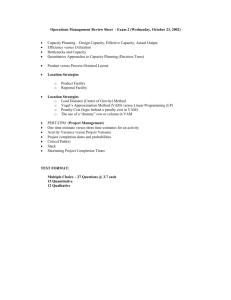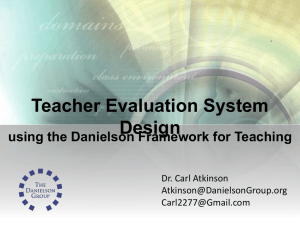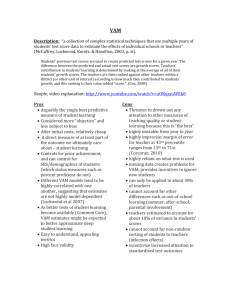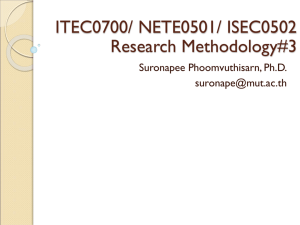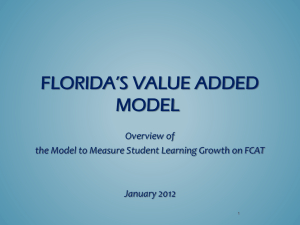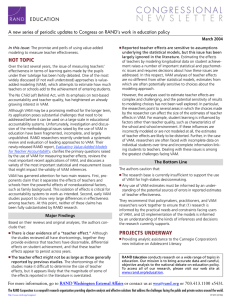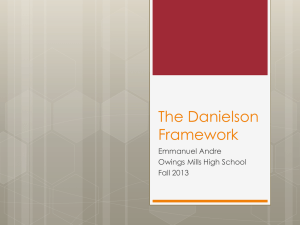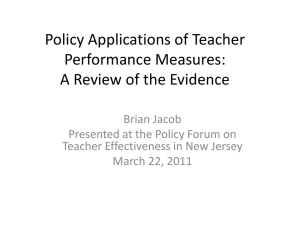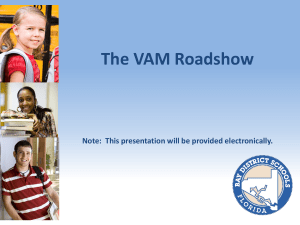Performance Appraisal for Teachers (PowerPoint Presentation)
advertisement
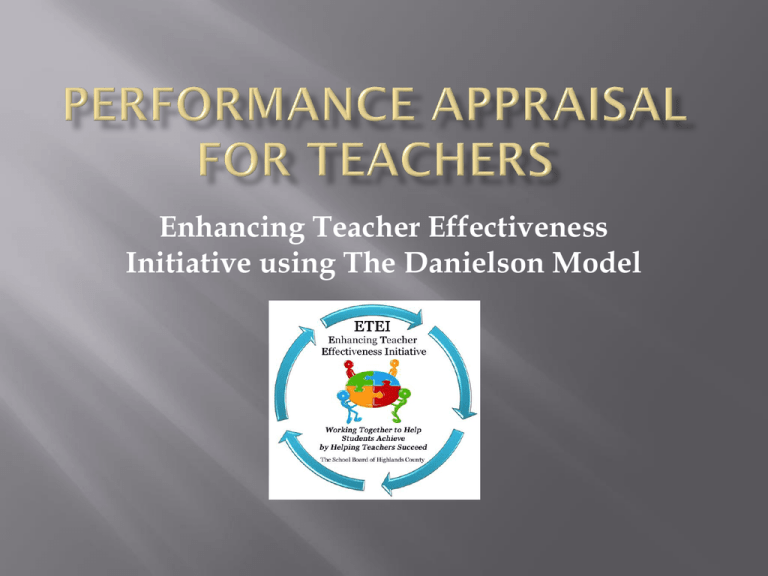
Enhancing Teacher Effectiveness Initiative using The Danielson Model A New Way of Doing Business Legislative Mandate Teacher evaluation – Charlotte Danielson Principal Evaluation – Doug Reeves Peer Evaluator Value-Added Model (VAM) Federal Grant- Race to the Top SBHC applied for and received federal funds (+$2 million) A requirement of the grant includes development of a performance appraisal system based upon a growth model for teachers and administrators and a system of compensation based upon student achievement data Senate Bill 736 – Student Success Act (1012.33/1012.34 FS) - Requires all school districts in Florida to implement research-based models of performance evaluation and include a system of performance pay. And, most importantly….. The “Ten Year Rule” It takes approximately ten years or 10,000 hours of deliberate practice to reach expert status. Number of years of experience is not necessarily a predictor of performance. Teachers progress through various stages on the way to becoming expert Factors include: Motivation Focused Feedback Focused Practice 2011-12 – implement teacher and school administrator performance appraisal system 2014 – Pay teachers and school administrators based upon performance appraisal system and student achievement data. (based upon 2013-14 data) 1. 2. 3. Ensuring quality of teaching and effectiveness of practices. Promoting teacher growth and learning. Improving student growth and achievement. 1. 2. 3. 4. Rigorous Valid Reliable Defensible Four Domains 1. Planning and Preparation 2. The Classroom Environment 3. Instruction 4. Professional Responsibilities Domains 2 and 3 are “onstage” domains and are weighted more than 1 and 4 (Danielson research) Knowing the content and understanding what we teach. Knowing the students (demographic information, academic background, special needs, etc) Understanding instructional materials and resources Understanding instructional design and assessment Time Standards for Conduct are clear and routine No loss of instructional time Respectful interactions among students and teacher Physical environment supports learning Students are engaged High quality activities and assignments Higher order questioning techniques Use of feedback and formative assessment Teacher Flexibility - Use of “Plan B” when necessary Differentiates instruction High Ethical Standards Professionalism Reflection on Instruction Regular attendance Accurate Record Keeping Frequent communication with families Participation in school events Professional Development Teacher provides a formative self-assessment Pre-conference-respond to a variety of written questions regarding the lesson to be observed and to determine the range of ability within the classroom Observe the lesson-collect/script evidence only; not opinion, interpretation, or emotion Post Conference-reflection; determine strengths and areas of development; make recommendations where appropriate Support for First Year Teachers and New to District; and Teachers in Need of Development Frequent, formative feedback ; 3-4 “pop-ins” per semester One Formal observation per semester (two per year) with Pre and Post Conferences 20% of Summative Evaluation Content Area Specialists, District Resource Teachers, others (outside experts) Professional Service Contract (PSC), Continuing Contract (CC) Teachers and Teachers with 4+ years of experience • One formal observation per year by school administrator (may conduct additional observations if needed) • 2-3 informal observations (walk-throughs, formative) per year • Performance Appraisal Ratings All Administrators and Peer Evaluators Certified by Cambridge Education Must use rubric and evidence Insures Inter-rater Reliability Does not promote “rater-bias” Planning – Unit planning; the big picture; developing prompts and activities that require students to use analysis, synthesis and evaluation Student engagement – student work, relevancy, focus on deep meaning; use higher order questioning techniques Communication with families – newsletters, phone logs, emails, etc. Professional Growth – attendance log of professional development activities, workshop or conferences; reflection Participation in a professional learning community (PLC) or action research project, log of school-wide or district committee service Highly Effective- meets stringent criteria in rubric; “elite” group of teachers; should have school-wide impact Effective – classroom impact and rating that encompasses most teachers Needs Improvement- developing skills and willing to improve practices Ineffective – Little to no evidence of practices that impact student learning (refer to generic ratings in Guidelines) The difference between the predicted performance and the actual performance represents the value added by the teacher’s instruction. 350 300 250 200 150 100 50 0 Student The predicted performance represents the level of performance the student is expected to demonstrate after statistically accounting for factors through a value-added model. Prior Performance Current Performance Predicted Performance Category I Teacher - FCAT Student Achievement VAM Score 50% Adminstrator 25% Peer 20% Teacher 5% Category II Teacher - FCAT Student Achievement VAM Score 50% Administrator 45% Teacher - Self 5% Category I Non-FCAT Student Achievement District Assessment 40% Student Achievement School VAM 10% Administrator 25% Peer 20% Category II Non-FCAT Student Achievement District Assessment 40% Student Achievement School VAM 10% Administrator 45% Teacher 5% State Growth Model – Value-Added covariance FCAT End of Course Exams SAT 10 for 2011-12 only; district selected assessment after 2011-12 IPDP – collaborative/conversations with principal (pre-post?) Student Achievement Goal Performance Appraisal (Instructional Practices) Goal Prescriptive Professional Development
